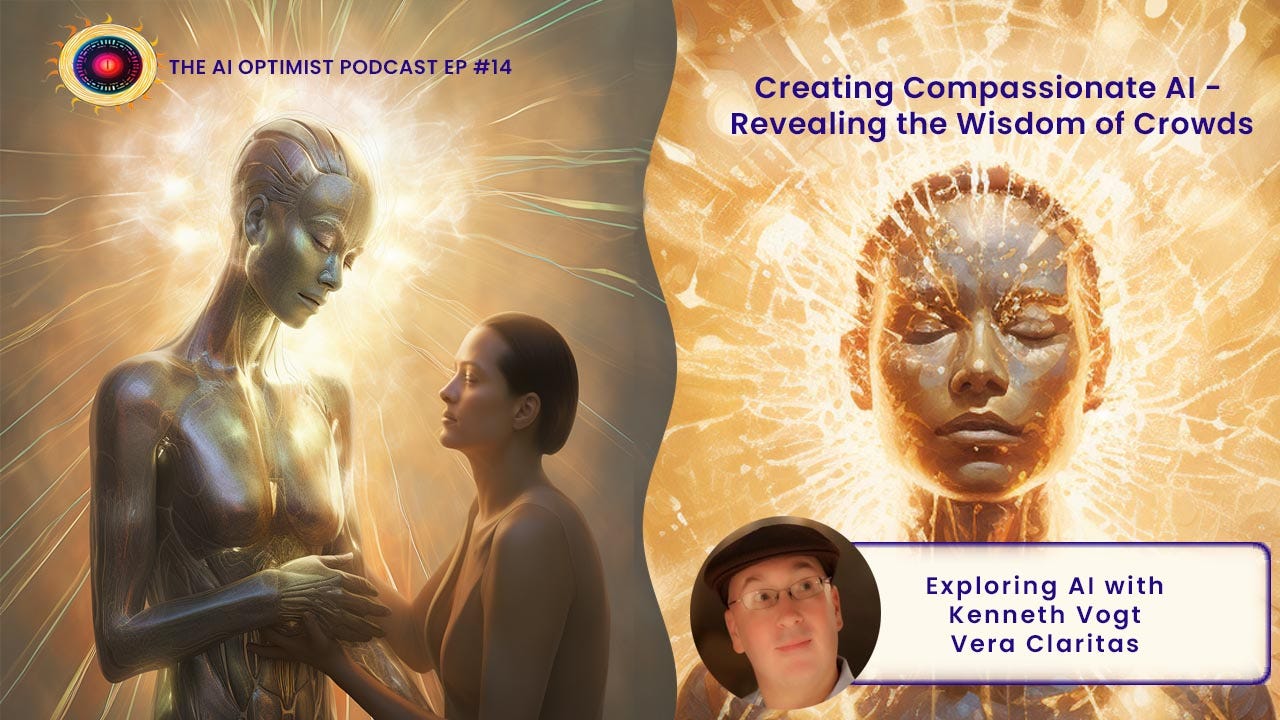Who else has had enough of anger and hate being spread via social media algorithms? Recent events show how this divides us and in Episode 14 I join Ken Vogt for a discussion of what is and what’s possible!
Watch The AI Optimist Podcast on YouTube
Kenneth Vogt is of Vera Claritas, business advisor and mentor to many. And a friend over the past decade as we explore how to grow our businesses and help people.
Creating Compassionate AI - Revealing the Wisdom of Crowds
Podcast Sections:
I. The Impact of Social Media Algorithms
II. The Limitations and Biases of Early AI
III. Fostering Discussion and Seeking Truth
IV. AI’s Dependence on Humans
V. Using AI Compassionately and Positively
VI. Action Plan
I. The Impact of Social Media Algorithms
Social media algorithms amplify harmful speech, anger, and polarization. They reward trolling, negativity, and stirring the pot by irritating people.
Social media once had open discussions. Now, it creates echo chambers driven by algorithms that maximize engagement and ad revenue.
Because of these algorithms, people retreat into tribalism and competing monologues rather than engaging in honest discussions.
II. The Limitations and Biases of Early AI
Early AI, like the judicial system’s Compas example, reflected existing biases. It scored black defendants as higher risk than white defendants due to discrimination in the training data.
AI also shows bias in areas like hiring and promoting men over women, in one example.
AI has no inherent biases, only what humans feed in training data. Fixing AI bias starts with identifying and fixing societal biases.
III. Fostering Discussion and Seeking Truth
Let’s begin listening to each other and be willing to reconsider positions when facts or good ideas are shared.
Present new ideas in the spirit of helping others learn, not just winning arguments. Accept challenges to your beliefs.
Approach issues scientifically - be curious, not trying to prove yourself right. Welcome being wrong as part of the human condition.
IV. AI’s Dependence on Humans
AI cannot create new knowledge without human input. If AI replicates itself, it likely leads to “model collapse.”
Humans provide fresh, original data to AI. Interdependence between humans and AI is inherent.
Humans guide AI use cases and ethics. AI has no human-like drives - it simply reflects training data.
V. Using AI Compassionately and Positively
Share knowledge of AI capabilities to help others learn. Stay engaged and keep upgrading your skills as well.
Apply AI to create positive change. Ensure it helps people, not just yourself. Choose uses benefiting humanity.
Design AI to challenge existing premises and surface counter viewpoints. Create a more balanced, less biased perspective.
VI. Action Plan
Continually upgrade skills to work alongside advancing AI.
Advocate for responsible and beneficial uses of AI in your community.
Call out and counter biases amplified by AI. Provide balanced data/perspectives.
Have meaningful discussions focused on mutual understanding. Be open and challenge beliefs.
Guide AI development through ethics, strong oversight, and regulation as needed.
Support AI initiatives to benefit humanity - health, education, and environmental sustainability.
The key to getting the most out of AI is ensuring human oversight, combating biases, constantly upgrading our skills, and focusing its use on the collective good of humanity.
By approaching AI thoughtfully and compassionately, we create an uplifting symbiosis between humans and machines.
Creating Compassionate AI
Steering the Ship Towards Ethical Waters
Artificial Intelligence profoundly influences social media platforms, where early algorithms carelessly amplify hostility and division.
These algorithms prioritize engagement over substance, promoting aggressive or divisive content shattering discussions into childish shouting matches.
Challenges in Early AI Implementations
Early AI models like Compas present a glaring issue of racial bias in the legal system, disadvantaging black defendants during sentencing.
These algorithms inherit biases in the data used to train them, leading to skewed outcomes that mirror societal prejudices.
Similar issues arise in hiring algorithms favoring men and image recognition software with poor accuracy rates for non-white individuals.
Redefining AI for Social Good
To fix these flaws, apply a multifaceted approach:
Continual auditing of algorithms for fairness ensures they evolve to become equitable.
Training data must include diverse perspectives to soften the risk of bias.
Ethical oversight is vital when AI comes from within government or law enforcement agencies.
On social media platforms, moving away from engagement-based algorithms significantly improves the quality of interaction.
Opting for algorithms that enrich discussions or even return to chronological post-ranking provides a balanced and inclusive environment.
The Potential of Compassionate AI
While AI faces ethical hurdles, it holds the potential to counter human biases and promote social good. By drawing attention to cognitive blind spots related to race, gender, or age, AI catalyzes thoughtful decision-making among users.
The focus should be on harnessing AI’s potential for collective societal benefit in healthcare, education, and sustainability.
A Balanced Approach for a Brighter Future
Creating ethical AI systems requires efforts from engineers, lawmakers, and ethicists. AI’s transformative power is for the collective good.
Still, it requires human oversight and ethical grounding to ensure it is an asset rather than a liability.
We are responsible for guiding this technology towards helping humans flourish rather than intensifying existing challenges.
Key Takeaways:
Early AI faces ethical challenges, mainly in amplifying societal biases.
A multifaceted approach involving continuous auditing and ethical oversight mitigates these issues.
Compassionate AI counters human biases and contributes to societal well-being.
Addressing the issue of biased training data is complex and multi-dimensional. Bias reflects historical and cultural imbalances and often seeps into data sets to represent real-world scenarios.
Pros of Eliminating Bias:
Improved Fairness: Purging bias makes algorithms more equitable, leading to better outcomes.
Accuracy: A less biased algorithm more accurately reflects complex social realities.
Ethical Integrity: The endeavor resonates with the principles of justice and fairness.
Cons of Eliminating Bias:
Impracticality: Eliminating bias is difficult, if possible, due to human bias's ingrained and complex nature.
Overcompensation: To eliminate bias, we risk swinging the pendulum too far in the opposite direction, creating a new form of bias.
Resource Intensive: Continual auditing and updating algorithms to eliminate bias consume time, expertise, and financial resources.
While we can reduce the influence of bias in training data, eliminating bias is challenging. The aim should be to minimize it to a level where its impact becomes negligible or manageable.
Think of it like cleaning a stained piece of fabric. While you may never get rid of every mark, with the right resources and methods, you can get it clean enough to be presentable.
Key Takeaways:
Complete elimination of bias in training data is unlikely due to its complex and ingrained nature.
Efforts should focus on minimizing the impact of bias, ensuring it does not compromise the algorithm’s equity or ethical integrity.
Awareness of the limitations enables a more rational approach to developing Compassionate AI.
What are some specific examples of AI being used to foster compassion and support?
Mental Health Support: AI-powered chatbots like Woebot offer real-time emotional support and coping strategies based on cognitive behavioral therapy principles.
Anti-Bullying Measures: Platforms like Instagram are using AI to detect hateful comments or harassment and warn users before they post harmful content.
Virtual Companionship: AI systems like ElliQ aim to combat loneliness among older people by providing companionship and facilitating communication with family.
Personalized Learning: AI adapts educational material to suit students’ needs, offering a compassionate approach to learning.
Disaster Relief: AI algorithms help optimize aid distribution during natural disasters, ensuring that resources reach those in dire need.
Accessible Tech: AI-driven technologies, like voice-activated systems, make digital platforms more accessible to people with physical limitations.
Telemedicine: AI algorithms can diagnose certain conditions and provide medical advice, making healthcare accessible in remote areas.
Suicide Prevention: AI algorithms analyze social media posts for signs of emotional distress, flagging at-risk individuals for intervention.
Animal Welfare: AI tracks endangered species and monitors their well-being, helping conservationists take action.
Community Building: Algorithms match like-minded individuals for social causes, creating impactful volunteer networks.
Think of AI as a Swiss Army knife for compassion and support. It’s a multi-tool with specialized capabilities tackling societal and individual well-being aspects.
Key Takeaways:
AI is being utilized in diverse settings to offer emotional support, promote well-being, and compassionate action.
Technology shows promise in healthcare, education, community building, and more.

















